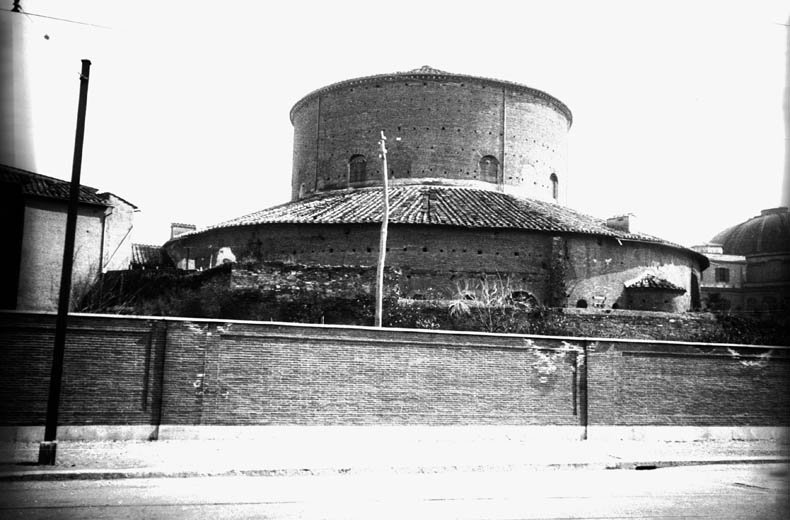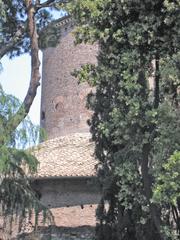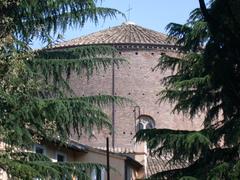
Santo Stefano Rotondo Rome: Visiting Hours, Tickets, and Complete Guide
Date: 14/06/2025
Introduction
Santo Stefano Rotondo, majestically set on Rome’s historic Caelian Hill, is one of the city’s most extraordinary early Christian basilicas. Distinguished by its rare circular design and profound religious significance, this remarkable church dates back to the late 5th century, likely constructed under Pope Simplicius (468–483). Dedicated to Saint Stephen, Christianity’s first martyr, whose relics were brought from the Holy Land, Santo Stefano Rotondo stands as a testament to Rome’s layered spiritual and architectural heritage (Understanding Rome; Liturgical Arts Journal).
Its striking rotunda—about 22 meters in diameter—features concentric ambulatories supported by spolia columns, salvaged from imperial Roman monuments. This “scavenger architecture” not only reflects resourcefulness but also symbolizes Christianity’s triumph over the city’s pagan past (Archweb; Romeing). Over the centuries, the church has been enriched artistically and serves today as both a spiritual hub and the Hungarian national church in Rome. Its proximity to major landmarks like the Colosseum and Roman Forum makes it an essential stop for history lovers, pilgrims, and art enthusiasts alike (VisitRome Substack; Italia.it).
Contents
- Historical Overview
- Origins and Early Christian Context
- Architectural Innovation and Symbolism
- Medieval and Renaissance Transformations
- Pilgrimage and National Identity
- Artistic and Archaeological Features
- Modern Restoration and Relevance
- Practical Visitor Information
- Location and Getting There
- Visiting Hours and Tickets
- Accessibility
- Guided Tours
- Travel Tips and Nearby Attractions
- Frequently Asked Questions (FAQ)
- Suggested Visuals and Resources
- Conclusion
Historical Overview
Origins and Early Christian Context
Santo Stefano Rotondo, officially San Stefano al Monte Celio, was erected in the latter half of the 5th century, a period marked by the decline of the Western Roman Empire (Understanding Rome; Liturgical Arts Journal). The church was built on the Caelian Hill, an area that had transitioned from an elite imperial residential district to a center of monastic and ecclesiastical life. Erected over the remains of a Roman barracks and a Mithraeum, the site reflects the Christianization of spaces once associated with the pagan and military past of Rome.
Architectural Innovation and Symbolism
What sets Santo Stefano Rotondo apart is its circular floor plan—an architectural rarity among Roman churches. Inspired by the Church of the Holy Sepulchre in Jerusalem and monumental Roman mausolea, the design emphasizes unity and eternity (Romeing). The original layout featured a triple-aisled rotunda encircled by two ambulatories supported by columns reused from ancient Roman structures (“spolia”). Although the outermost ring has been lost, the core structure and the sense of sacred enclosure remain intact (Archweb).
The fusion of classical and Christian elements is evident in the entrance portico, which boasts five granite arches and Corinthian capitals. This architectural approach underscores Christianity’s roots in, and transformation of, Rome’s imperial legacy.
Medieval and Renaissance Transformations
After periods of neglect in the Middle Ages, including the loss of the original roof, the church underwent significant restoration in the Renaissance. In the late 16th century, Pope Gregory XIII commissioned a powerful cycle of 34 frescoes depicting the martyrdom of early Christian saints, painted by Niccolò Circignani (“Il Pomarancio”) and Antonio Tempesta (Liturgical Arts Journal; Romeing). These vivid, emotionally charged artworks were intended to inspire faith and devotion during the Counter-Reformation.
Pilgrimage and National Identity
Santo Stefano Rotondo was a major stop for pilgrims traveling the Via Francigena in the Middle Ages and continues to play a key role as the Hungarian national church in Rome, hosting Hungarian-language liturgies and cultural events (Italia.it; Romeing).
Artistic and Archaeological Features
Among the church’s treasures is the Chapel of Saints Primo and Feliciano, home to a rare 7th-century mosaic showing the saints beside a jeweled cross (Liturgical Arts Journal). The use of spolia columns and the dramatic frescoes connect visitors directly to Rome’s ancient and early Christian heritage.
Modern Restoration and Relevance
Significant restorations in the modern era have preserved both the architectural integrity and the artwork of Santo Stefano Rotondo (Romeing). Today, the church remains a tranquil sanctuary for worship, weddings, and cultural events. Its continued role during Jubilee years and as a community hub highlights its ongoing relevance in Rome’s sacred and cultural landscape (Italia.it).
Practical Visitor Information
Location and Getting There
- Address: Via di Santo Stefano Rotondo, 7, Caelian Hill (Celio), Rome
- Nearest Metro: Colosseo (Line B), approx. 15-minute walk
- Bus: Several lines stop at Navicella, just a few minutes from the church (VisitRome Substack; MamalovesRome)
Visiting Hours and Tickets
- Opening Hours: Typically Tuesday to Sunday, 9:00 AM – 5:00 PM. Closed Mondays and public holidays. Hours may vary during special events, so check local listings or official sources before your visit.
- Tickets: Entry is free of charge, making it accessible for all visitors.
- Guided Tours: Occasionally available through local operators or during special events. For a deeper understanding, consider booking a tour in advance (Romeing).
Accessibility
Santo Stefano Rotondo accommodates visitors with limited mobility, though some areas may have uneven flooring typical of ancient structures. Wheelchair users are encouraged to contact the church in advance to confirm accessibility arrangements.
Travel Tips and Nearby Attractions
- Best Times: Early mornings or weekdays for fewer crowds and optimal photography conditions, as natural light filters dramatically through the church.
- Dress Code: Modest attire is recommended in respect for the sacred space.
- Nearby Sites: The Colosseum, Basilica of San Clemente, Basilica of Santi Giovanni e Paolo, and Parco della Caffarella are all within walking distance, making it easy to combine your visit with other major landmarks (MamalovesRome; VisitRome Substack).
Suggested Visuals and Resources
- Images:
- Interior view of the circular nave with the caption, “Interior circular nave of Santo Stefano Rotondo, Rome.”
- Frescoes of martyrdom scenes, captioned, “16th-century frescoes of Christian martyrdoms inside Santo Stefano Rotondo.”
- 7th-century mosaic in the Chapel of Saints Primo and Feliciano, captioned, “Early medieval mosaic of Saints Primo and Feliciano at Santo Stefano Rotondo.”
- Map: Show the church’s location relative to Colosseo Metro and nearby attractions.
- Virtual Tours: Seek out 360-degree videos or official church resources if available.
Frequently Asked Questions (FAQ)
Q: What are the visiting hours of Santo Stefano Rotondo?
A: Usually open Tuesday to Sunday, 9:00 AM – 5:00 PM. Closed Mondays and public holidays. Confirm with local sources in advance.
Q: Is there an entry fee?
A: No, entry is free, though donations are welcome.
Q: Is the church wheelchair accessible?
A: The site is generally accessible, though some historic flooring may be uneven.
Q: Are guided tours available?
A: Yes, through local tour operators or during special events.
Q: Can I take photos inside the church?
A: Photography is usually permitted, but please be discreet during services.
Q: What are the best spots for photography?
A: The central nave, the fresco cycle, and the Chapel of Saints Primo and Feliciano’s mosaic are highlights.
Conclusion
Santo Stefano Rotondo offers a singular experience among Rome historical sites—a harmonious blend of rare architectural design, evocative Counter-Reformation frescoes, and a peaceful, contemplative setting. Its rich history, from its origins as a martyrium to its modern role as a cultural and spiritual hub, makes it a must-see for anyone interested in early Christian art, architecture, or pilgrimage traditions.
Before visiting, check current opening hours and consider joining a guided tour to fully appreciate the church’s significance. Take time to explore neighboring sites on the Caelian Hill and enjoy this tranquil retreat just steps away from the Colosseum.
For more detailed guides, audio tours, and updates on Rome’s hidden gems, download the Audiala app and follow our social media channels. Stay tuned for ongoing tips and stories about Rome’s enduring cultural and spiritual legacy.
Summary of Key Visiting Tips
- Free admission and convenient opening hours make Santo Stefano Rotondo accessible to all.
- Unique circular architecture and dramatic frescoes provide a memorable experience.
- Wheelchair accessible with some caveats; check ahead for special needs.
- Combine your visit with nearby historical attractions for a comprehensive day in Rome.
- Use official tourism platforms or the Audiala app for the latest updates and guided resources.
Sources
- Liturgical Arts Journal
- Archweb
- Visit-Colosseum-Rome.com
- MamalovesRome
- Romeing
- Understanding Rome
- Italia.it
- VisitRome Substack
- TurismoRoma
- Saturdays in Rome
- Wikipedia
- triphobo.com



















































































































































































































































